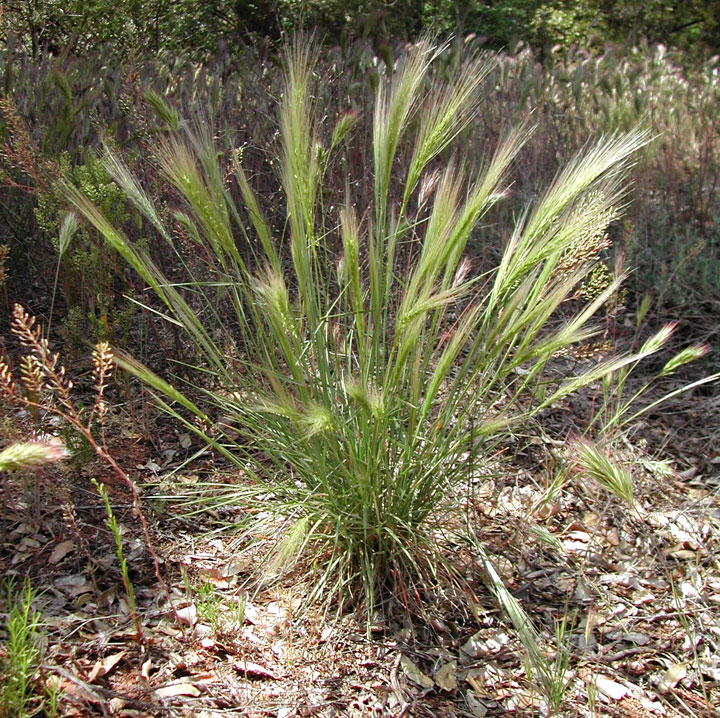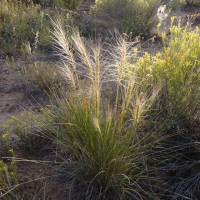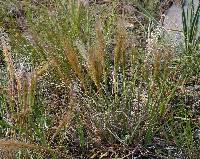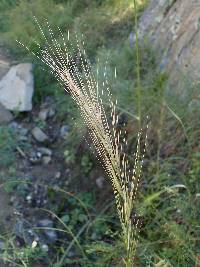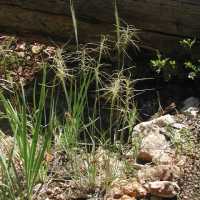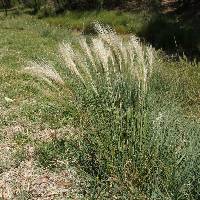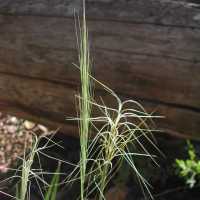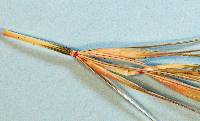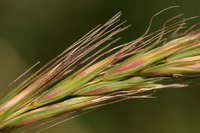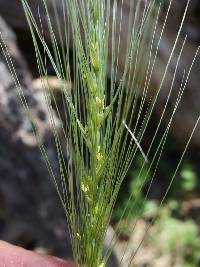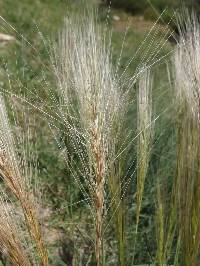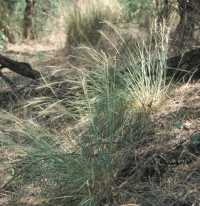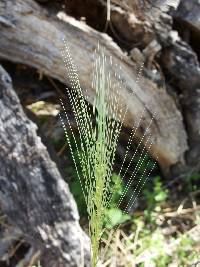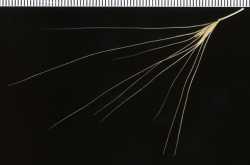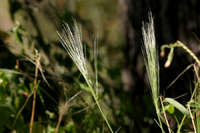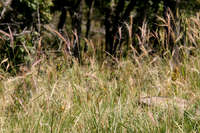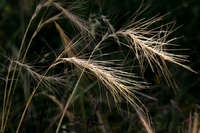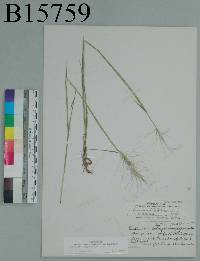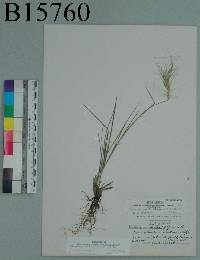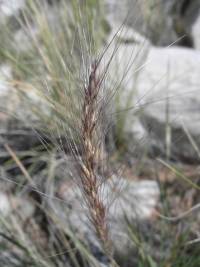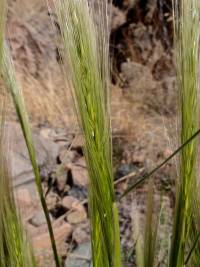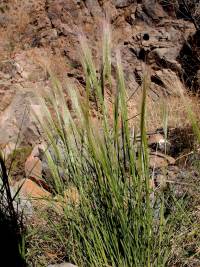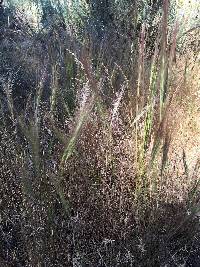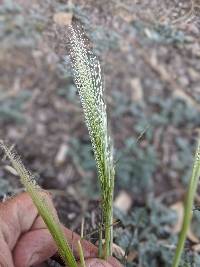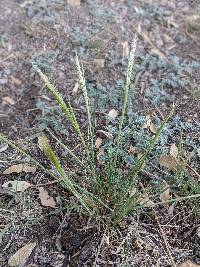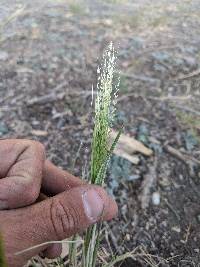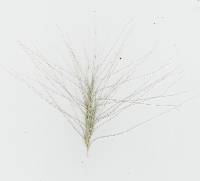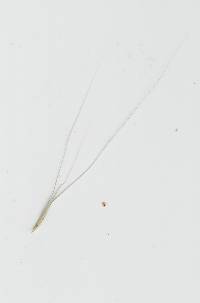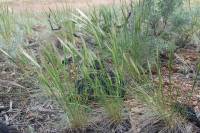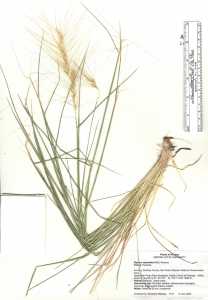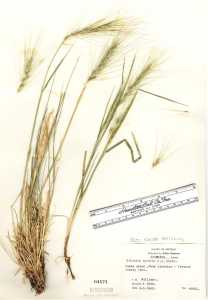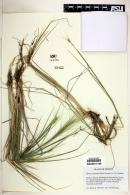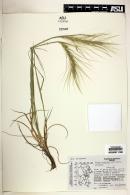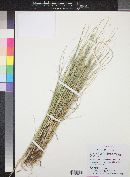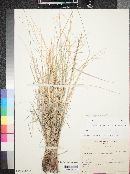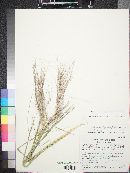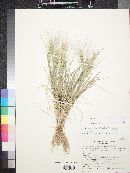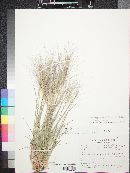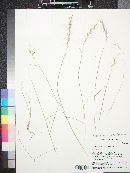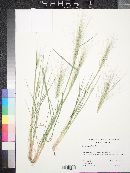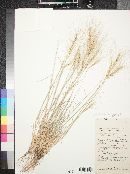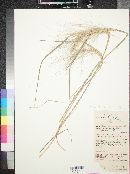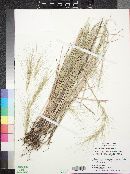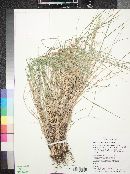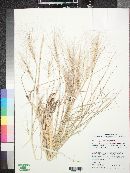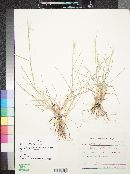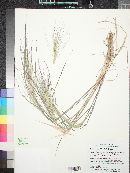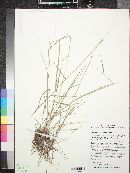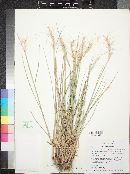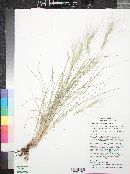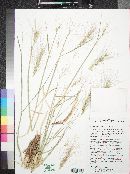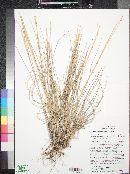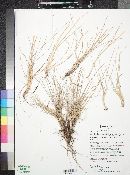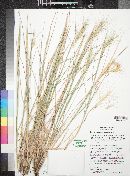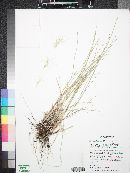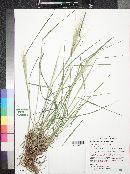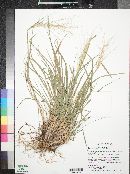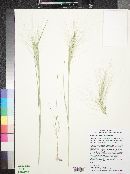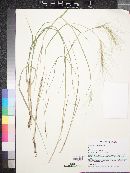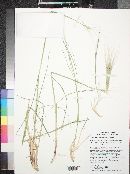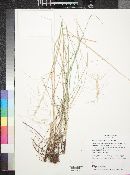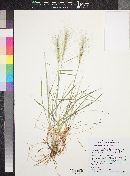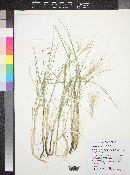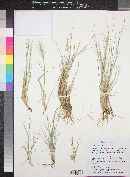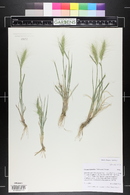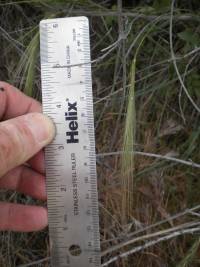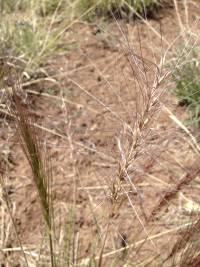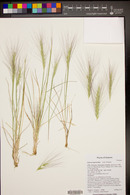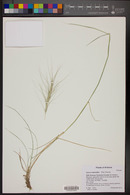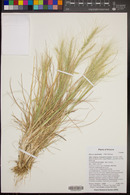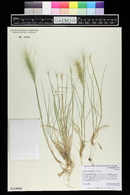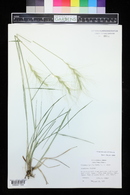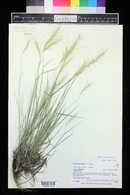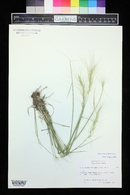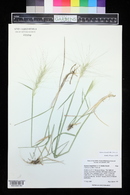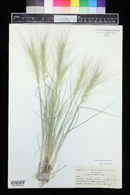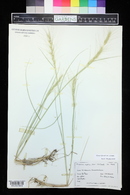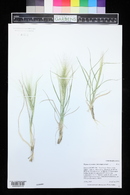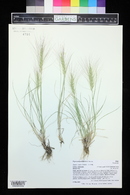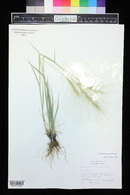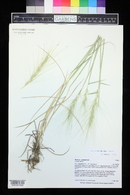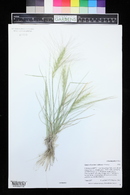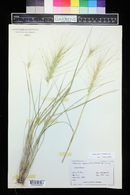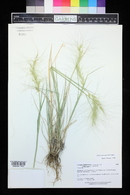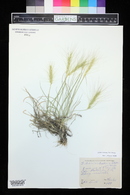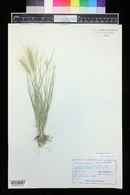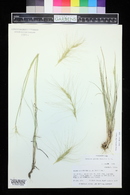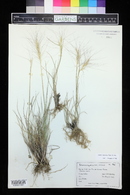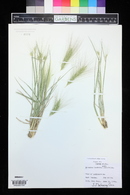Elymus elymoides
|
|
|
|
Family: Poaceae
Western Bottle-Brush Grass, more...squirreltail, bottlebrush squirreltail (es: zacate ladera, cola de ardilla)
[Aegilops hystrix Nutt., moreElymus difformis Nutt. ex J.G. Sm., Elymus glaber (J.G. Sm.) Burtt Davy, Elymus insularis (J.G. Sm.) M.E. Jones, Elymus minor (J.G. Sm.) M.E. Jones, Elymus pubiflorus (J.G. Sm.) Burtt Davy, Hordeum elymoides (Raf.) Schenck, Sitanion albescens Elmer, Sitanion basalticola Piper, Sitanion brevifolium J.G. Sm., Sitanion caespitosum J.G. Sm., Sitanion ciliatum Elmer, Sitanion cinereum J.G. Sm., Sitanion glabrum J.G. Sm., Sitanion hystrix var. hystrix , Sitanion insulare J.G. Sm., Sitanion latifolium Piper, Sitanion minus J.G. Sm., Sitanion montanum J.G. Sm., Sitanion rigidum , Sitanion strigosum] |
Plants cespitose, often glaucous, not rhizomatous. Culms 8-65(77) cm, erect or geniculate to slightly decumbent, sometimes puberulent; nodes 4-6, mostly concealed, usually glabrous, sometimes pubescent. Leaves evenly distributed; sheaths glabrous, scabrous, puberulent, or densely white-villous; auricles usually present, to about 1 mm, often purplish; ligules shorter than 1 mm, truncate, entire or lacerate; blades (1)2-4(6) mm wide, spreading or ascending, often involute, sometimes folded, abaxial surfaces glabrous to puberulent, adaxial surfaces scabrous, puberulent, hirsute, or white-villous. Spikes 3-20 cm long, 5-15 cm wide, erect to subflexuous, with 2-3 spikelets per node, rarely with 1 at some nodes; internodes 3-10(15) mm long, 0.1-0.4 mm thick at the thinnest sections, usually glabrous, sometimes puberulent beneath the spikelets. Spikelets 10-20 mm, divergent, sometimes glaucous, at least 1 spikelet at a node with 2-4(5) florets, 1-4(5) florets fertile, sometimes all florets sterile in the lateral spikelets; disarticulation initially at the rachis nodes, subsequently beneath each floret. Glumes subequal, 20-135 mm including the often undifferentiated awns, the bases indurate and glabrous, glume bodies 5-10 mm long, 1-3 mm wide, linear to setaceous, 1-3-veined, margins firm, awns 15-125 mm, scabrous, sometimes split into 2-3 unequal divisions, flexuous to outcurving from near the base at maturity; fertile lemmas 6-12 mm, glabrous, scabrous, or appressed-pubescent, 2 lateral veins extending into bristles to 10 mm, awns 15-120 mm long, about 0.4 mm wide at the base, often reddish or purplish, scabrous, flexuous to curved near the base; paleas 6-11 mm, veins often extending into bristles to 2(5) mm, apices acute to truncate; anthers 0.9-2.2 mm. Anthesis from late May to July. 2n = 28. Elymus elymoides grows in dry, often rocky, open woods, thickets, grasslands, and disturbed areas, from sagebrush deserts to alpine tundra. It is widespread in western North America, from British Columbia to northern Mexico and the western Great Plains, and introduced in western Missouri, Illinois, and Kentucky. It is often dominant in overgrazed pinyon-juniper woodlands. Although palatable early in the season, the disarticulating, long-awned spikes irritate grazing animals later in the year. Elymus elymoides intergrades with E. multisetus -in parts of its southern range ( Wilson 1963). It is sometimes confused with E. scribneri , but differs in having more than one spikelet per node, narrower glumes, and less tardily disarticulating rachises. Hybrids with several other species in the Triticeae -are known; they can often be recognized by their tardily disarticulating rachises. Named interspecific hybrids (and the other parent) are E. -saundersii -(E. trachycaulus ), E. -pinaloensis -(E. arizonicus ), and possibly E. -hansenii -(E. elymoides or E. multisetus -- E. glaucus ). Hybrids with E. sierrae -have not been named; they are common where the two species are sympatric. They have broader glume bases, shorter glume awns, and longer anthers than E. elymoides. Dr. David Bogler, USDA NRCS PLANTS Database Perennials, Terrestrial, not aquatic, Stems nodes swollen or brittle, Stems erect or ascending, Stems caespitose, tufted, or clustered, Stems terete, round in cross section, or polygonal, Stem internodes hollow, Stems with inflorescence less than 1 m tall, Stems with inflorescence 1-2 m tall, Stems, culms, or scapes exceeding basal leaves, Leaves mostly cauline, Leaves conspicuously 2-ranked, distichous, Leaves sheathing at base, Leaf sheath mostly open, or loose, Leaf sheath smooth, glabrous, Leaf sheath hairy, hispid or prickly, Leaf sheath and blade differentiated, Leaf blades linear, Leaf blade auriculate, Leaf blades 2-10 mm wide, Leaf blades 1-2 cm wide, Leaf blades mostly flat, Leaf blade margins folded, involute, or conduplicate, Leaf blades mostly glabrous, Leaf blades more or less hairy, Ligule present, Ligule an unfringed eciliate membrane, Inflorescence terminal, Inflorescence simple spikes, Inflorescence a dense slender spike-like panicle or raceme, branches contracted, Inflorescence solitary, with 1 spike, fascicle, glomerule, head, or cluster per stem or culm, Inflorescence single raceme, fascicle or spike, Inflorescence spikelets arranged in a terminal bilateral spike, Flowers bisexual, Spikelets pedicellate, Spikelets sessile or subsessile, Spikelets laterally compressed, Spikelet less than 3 mm wide, Spikelets with 2 florets, Spikelets with 3-7 florets, Spikelets paired at rachis nodes, Spikelets all alike and fertille, Spikelets bisexual, Inflorescence disarticulating between nodes or joints of rachis, rachis fragmenting, Spikelets disarticulating above the glumes, glumes persistent, Spikelets disarticulating beneath or between the florets, Rachilla or pedicel hairy, Rachilla or pedicel glabrous, Glumes present, empty bracts, Glumes 2 clearly present, Glumes equal or subeq ual, Glumes shorter than adjacent lemma, Glumes equal to or longer than adjacent lemma, Glumes awn-like, elongated or subulate, Glumes awned, awn 1-5 mm or longer, Glumes 3 nerved, Glumes 4-7 nerved, Lemmas thin, chartaceous, hyaline, cartilaginous, or membranous, Lemma similar in texture to glumes, Lemma 5-7 nerved, Lemma glabrous, Lemma body or surface hairy, Lemma apex acute or acuminate, Lemma distinctly awned, more than 2-3 mm, Lemma with 1 awn, Lemma with 3 awns, Lemma awn less than 1 cm long, Lemma awn 1-2 cm long, Lemma awn 2-4 cm long or longer, Lemma awned from tip, Lemma margins thin, lying flat, Lemma straight, Palea present, well developed, Palea membranou FNA 2007, Gould 1980 Common Name: squirreltail Duration: Perennial Nativity: Native Lifeform: Graminoid General: Annual bunchgrass with erect, geniculate, or slightly decumbent stems, often glaucous, 8-65 cm tall; nodes 4-6 per culm, glabrous and mostly concealed. Vegetative: Leaves evenly distributed along culms; sheaths glabrous, scabrous to densely white-villous; auricles usually present, to 1 mm, often purplish; ligules shorter than 1 mm, truncate, entire or lacerate; blades 2-4 mm wide, often involute; lower surfaces glab Inflorescence: Spikes 3-20 cm long, 5-15 cm wide, erect to subflexuous, with clusters of 2-3 spikelets at each node; spikelets 1-2 cm with 2-4 florets, sometimes one or more florets sterile; glumes indurate at base, subequal in length, 2-14 cm including awns; fertile lemmas 6-12 mm, glabrous to appressed-pubescent, 2 lateral veins extending into bristles to 1 cm, awns 1.5-12 cm long, often reddish or purplish, scabrous, and curved near the base; paleas 6-11 mm, veins often extending into bristles to 2 mm, apices acute to truncate; disarticulation initially at the rachis nodes, subsequently beneath each floret. Ecology: Dry, often rocky, but wide-ranging habitats from open woods to grasslands to disturbed areas from 2,000-11,500 ft (610-3505 m), flowers March-August. Distribution: Widespread in western N. America from s CAN to n MEX. Notes: Distinctive as a perennial bunchgrass possessing an inflorescence of spikelets, (usually) two at each node and stacked up the axis, with very long awns that curve outward when dry, making the entire inflorescence resemble a bottlebrush. Considered one of the most fire resistant of all native bunchgrasses and provides good forage. E. elymoides is an incredibly common forest and woodland understory species in Arizona; Flora Neomexicana (2012) and the Four Corners Flora (2013) consider it to not occur in New Mexico, giving their local counterpart the name Elymus longifolius. E. longifolius is distinguished from E. elymoides based on the first floret in each spikelet being well developed and fertile. (In E. elymoides the first floret in at least one spikelet per node is reduced to an awn.) However, Flora of North America considers the New Mexican species E. longiflorus to be synonymous with E. elymoides subsp. brevifolius, which is why it is treated as E. elymoides here. Ethnobotany: Used as forage, although the awns on mature fruits irritate animals' mouths. Etymology: Elymus comes form Greek name elymos for millet, while elymoides means like the genus Elymus. Synonyms: Elymus sitanion, Sitanion slymoides, S. hystrix Editor: SBuckley 2010/2021, FSCoburn 2014, AHazelton 2015 |
|
|
|

